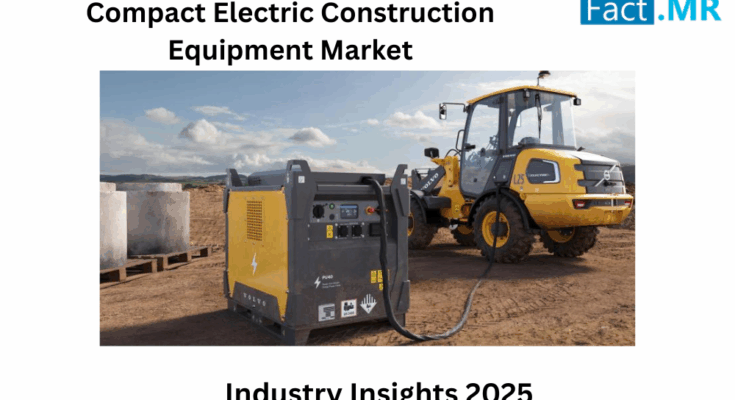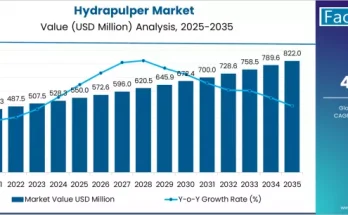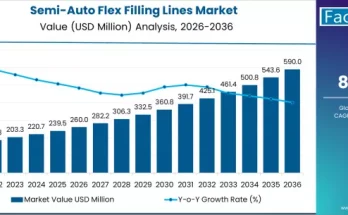In 2024, the global compact electric construction equipment market is valued at approximately US$ 62.12 billion, and it is projected to soar to US$ 214.63 billion by 2034, growing at a compound annual growth rate (CAGR) of about 13.2%. This remarkable growth reflects a strong shift toward sustainable construction practices, driven by environmental regulation, technological breakthroughs in battery and motor systems, and the rising demand for quieter, zero-emission machinery in urban and indoor job sites.
What’s Fueling the Surge
Several potent forces are accelerating the adoption of compact electric construction equipment. First, governments worldwide are enforcing more stringent emissions and noise pollution regulations, making electric alternatives more attractive. Urbanization is another key driver: compact equipment works well in tight spaces and dense infrastructure projects, where maneuverability and low environmental impact are essential. Meanwhile, battery technologies (such as improvements in energy density, charging speed, and battery life), electric motor efficiency, and innovations in charging infrastructure are helping reduce the performance and cost gaps versus traditional diesel-powered machines. Finally, awareness among contractors and equipment rental firms of total cost of ownership benefits—lower fuel cost, less maintenance, reduced downtime—is pushing investment in electric gear.
Market Segmentation & Key Product Trends
The market encompasses several product types—forklifts, loaders, excavators, and aerial work platforms (AWPs). Among these, forklifts lead in market share and are expected to generate the largest revenue share by 2034, particularly due to their widespread use in material handling, warehousing, and mixed indoor/outdoor applications. The below-5-ton load-carrying capacity segment also dominates; these lightweight, compact machines are ideal for urban, constrained, or indoor environments. As machine capacity increases (6-8 tons, 8-10 tons), growth is also evident but from a smaller base.
Other design trends include integration of smart telematics, predictive maintenance, remote monitoring, and features that enhance uptime. Noise reduction, safety enhancements (especially for operator comfort in indoor or semi-enclosed environments), and modular battery systems are also gaining attention.
Regional Dynamics: U.S. & Europe Insights
United States
The U.S. market is one of the fastest growing. With rising infrastructure investment, clean-air policies, and stricter emissions standards, demand for electric compact construction machines is accelerating. In 2024, the U.S. share of the global market is significant, and its growth rate is slightly above the global average, driven especially by electric forklifts and loaders. Regulatory incentives, state and federal subsidies for zero-emission equipment, and strong manufacturing and innovation ecosystems are helping domestic OEMs and contractors to adopt electric options more rapidly.
Europe
Europe remains a vital market, with countries like Germany, France, the U.K., and Nordic nations leading in adoption. European regulatory regimes, green building certification programs, and urban planning policies favor electric and low-emission equipment. Contractors working in municipalities, infrastructure projects, and projects near residential zones are particularly inclined toward compact electric machines, owing to their lower noise, minimal emissions, and regulatory compliance. Europe also tends to host many pilot projects and early adoptions, helping to validate models and build supply chains.
Recent Developments & Innovation Highlights
Recent years have seen meaningful technological and business innovations. Battery packs with higher capacity, faster charging, and longer lifespans are making electric machines more commercially viable. Hybrid electric versions are being developed to bridge the gap in regions where charging infrastructure is less mature. OEMs are releasing new compact excavators, wheel loaders, and aerial platforms with improved specifications. Telematics, remote diagnostics, and predictive maintenance routines are helping operators optimize machine utilization and reduce unplanned downtime. Also, some players are exploring second-life battery reuse or recycling programs to reduce environmental footprint and cost.
Challenges & Market Barriers
Several constraints still temper the pace of adoption. The high upfront cost of electric machinery and batteries is a major investment barrier, especially for smaller contractors or rental firms. Charging infrastructure—both onsite and public—is often inadequate, particularly in rural or developing regions. Concerns about battery lifecycle, degradation, replacement cost, and availability of spare parts are common among end users. Performance under heavy or continuous load, or in harsh environments (dust, moisture, heat), can still favor diesel or hybrid alternatives. Also, regulatory and incentive policies vary widely across countries, so equipment that is commercially viable in one region may be less so in another.
Competitive Landscape & Key Players
The competitive field includes both legacy heavy construction equipment OEMs and more specialized electric-equipment manufacturers. Notable players include names such as Caterpillar, J.C. Bamford Excavators Limited (JCB), Deere & Company, Volvo CE, Hyundai Construction Equipment Co. Ltd., Toyota, Bobcat, Hitachi Construction Machinery, Wacker Neuson, SANY Group, and others. These companies compete on motor and battery performance, durability, operator comfort, charging compatibility, cost-of-ownership, and service/support networks. Partnerships with battery manufacturers, investment in R&D, and pilot projects are shaping who will lead in performance, brand trust, and infrastructure readiness.
Forecast & Strategic Implications
By 2034, the market is expected to more than triple in value, growing from ~US$ 62.12 billion in 2024 to ~US$ 214.63 billion. The most rapid growth will be seen in forks, loaders, and below-5-ton machines, especially in urban construction, materials handling, and infrastructure repair/maintenance sectors. Regions with strong regulatory support, good grid infrastructure, and incentives will pull ahead. For manufacturers and investors, strategic priorities include:
-
Scaling up battery and motor technology R&D to push down cost and improve energy efficiency.
-
Investing in charging infrastructure, service networks, and battery recycling or second-life programs.
-
Designing machines tailored for urban, confined, or indoor environments (low noise, emission, compact form factor).
-
Offering flexible financing, leasing, or rental models to reduce barrier of entry for smaller contractors.
-
Keeping an eye on regulations, incentives, and environmental policy shifts, which can dramatically affect adoption curves.
Browse Full Report: https://www.factmr.com/report/compact-electric-construction-equipment-market
Editorial Perspective
The compact electric construction equipment market is more than an engineering shift—it’s a reflection of evolving global priorities: cleaner air, urban livability, climate responsibility, and efficient resource usage. As electric machines become more capable, cost-competitive, and supported by infrastructure, they will increasingly become the default choice for many job sites, not the exception. Companies that can offer dependability, good service, and smart total cost of ownership will define leadership; those who depend only on legacy ICE (internal combustion engine) models are likely to be left behind.



